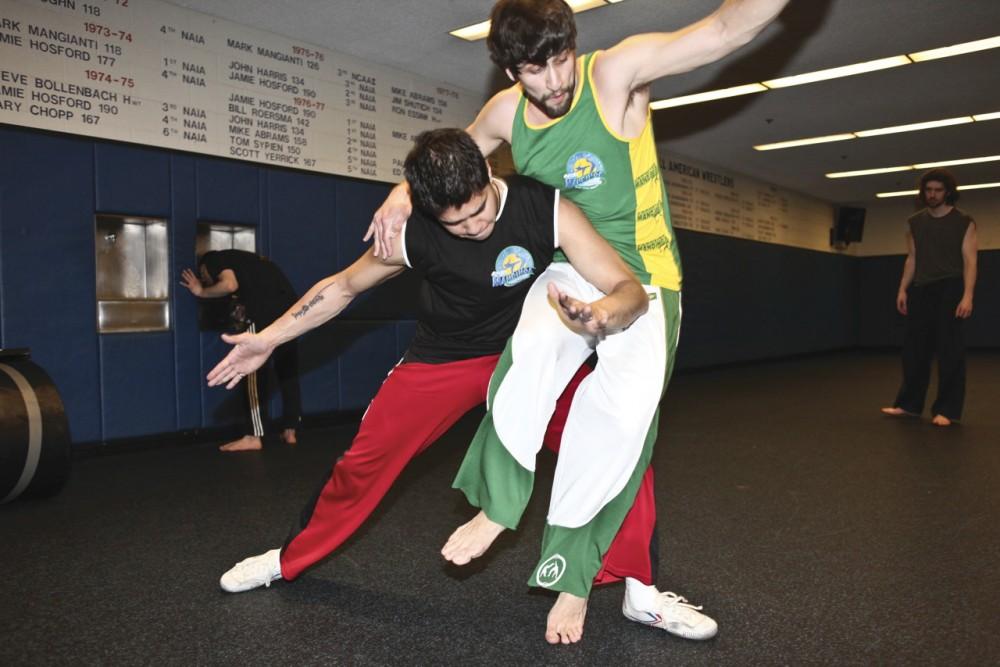Campus group uses Afro-Brazilian martial art to battle breast cancer

The Afro-Brazilian martial art of Capoeira Mandinga is a combination of dance and fighting.
Apr 1, 2010
The National Cancer Institute, a component of the National Institutes of Health, estimates that 12.7 percent of women born today will be diagnosed with breast cancer at some time in their lives.
Grand Valley State University’s Capoeira Mandinga group is hosting its second annual Capo for the Cure event the week of April 12-17 on the Allendale Campus to fight these statistics.
“Monday, Tuesday, Thursday and Friday we will have a table in Kirkhof where we will sell breast cancer ribbon T-shirts for $10, bracelets for $1, raffle tickets for $1 and Xyience energy drinks for $2,” said Angelica Pena, Capoeira Mandinga’s financial officer.
Saturday will bring outdoor martial arts performances in addition to selling merchandise. The raffle will be drawn on Sunday, for the chance to win a six-pack of Xyience, free Samba dance lessons, a $35 gift certificate to Uccello’s and a custom-made poster.
At first glance, it is hard to tell if Capoeira Mandinga is a style of dance or a method of fighting. In actuality it is both.
Capoeira Mandinga, pronounced cap-oh-air-ah, is an Afro-Brazilian martial art that has been around since the 1600s. The GVSU Capoeira Mandinga Web site tells the story of the art form.
“It was developed by African slaves in Brazil,” the Web site states. “Capoeira began to take form among the community of slaves that worked on the sugar cane plantations, the docks and various other slave works. It became a strong weapon in the life-and-death struggle against their oppressors. When the owners of the sugar cane fields realized the power of capoeira, they began to punish those who practiced it, sometimes with death. Capoeiristas learned to camouflage the forbidden fight with singing and clapping as though it were simply entertainment. The fight was disguised behind the dance – a dance that could be as graceful as a panther and as treacherous as a snake.”
Juston Espinoza, who teaches Capoeira Mandinga at GVSU and Grand Rapids Brazilian Jiu Jitsu Academy, said the group of GVSU, Grand Rapids and Woodland, Mich., participants has about 30 to 40 members, but internationally there are hundreds of followers.
“Our group is always open to those who would like to try something new,” he added. “There are no age/physique/experience requirements, just a willingness to try.”
Last year’s Capo for the Cure event raised $500, but the group hopes with the extra advertising this year to raise even more with all proceeds going to the National Breast Cancer Foundation.
Juston said their goal is to raise between $1,000 and $1,500.
“Breast cancer is prevalent in women, we wanted to show them our support,” Pena said on why the group chose this philanthropy. “We wanted to show that Capoeira is for everyone, regardless of gender. It also just seems like a great cause that many people can get behind.”
Pena said showing up to their classes is the best way to get involved. Capoeira Mandinga holds their classes at different times each semester, including summer, depending on space availability. This semester classes are Tuesdays 8 p.m. to 9:30 p.m., Thursdays 6 p.m. to 7:30 p.m. and Sundays 11:30 a.m. to 2 p.m. All of the classes are held in the lower level of the Fieldhouse in the multipurpose room.
Those interested in learning more about Capoeira Mandinga can e-mail the group at [email protected] or visit the Web site at http://www. gvsumandinga.org.






















